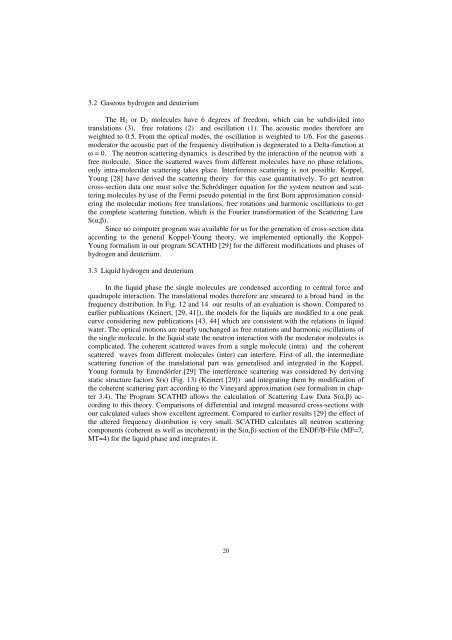Druck-Materie 20b.qxd - JUWEL - Forschungszentrum Jülich
Druck-Materie 20b.qxd - JUWEL - Forschungszentrum Jülich
Druck-Materie 20b.qxd - JUWEL - Forschungszentrum Jülich
Create successful ePaper yourself
Turn your PDF publications into a flip-book with our unique Google optimized e-Paper software.
3.2 Gaseous hydrogen and deuterium<br />
The H2 or D2 molecules have 6 degrees of freedom, which can be subdivided into<br />
translations (3), free rotations (2) and oscillation (1). The acoustic modes therefore are<br />
weighted to 0.5. From the optical modes, the oscillation is weighted to 1/6. For the gaseous<br />
moderator the acoustic part of the frequency distribution is degenerated to a Delta-function at<br />
ω = 0. The neutron scattering dynamics is described by the interaction of the neutron with a<br />
free molecule. Since the scattered waves from different molecules have no phase relations,<br />
only intra-molecular scattering takes place. Interference scattering is not possible. Koppel,<br />
Young [28] have derived the scattering theory for this case quantitatively. To get neutron<br />
cross-section data one must solve the Schrödinger equation for the system neutron and scattering<br />
molecules by use of the Fermi pseudo potential in the first Born approximation considering<br />
the molecular motions free translations, free rotations and harmonic oscillations to get<br />
the complete scattering function, which is the Fourier transformation of the Scattering Law<br />
S(α,β).<br />
Since no computer program was available for us for the generation of cross-section data<br />
according to the general Koppel-Young theory, we implemented optionally the Koppel-<br />
Young formalism in our program SCATHD [29] for the different modifications and phases of<br />
hydrogen and deuterium.<br />
3.3 Liquid hydrogen and deuterium<br />
In the liquid phase the single molecules are condensed according to central force and<br />
quadrupole interaction. The translational modes therefore are smeared to a broad band in the<br />
frequency distribution. In Fig. 12 and 14 our results of an evaluation is shown. Compared to<br />
earlier publications (Keinert, [29, 41]), the models for the liquids are modified to a one peak<br />
curve considering new publications [43, 44] which are consistent with the relations in liquid<br />
water. The optical motions are nearly unchanged as free rotations and harmonic oscillations of<br />
the single molecule. In the liquid state the neutron interaction with the moderator molecules is<br />
complicated. The coherent scattered waves from a single molecule (intra) and the coherent<br />
scattered waves from different molecules (inter) can interfere. First of all, the intermediate<br />
scattering function of the translational part was generalised and integrated in the Koppel,<br />
Young formula by Emendörfer [29] The interference scattering was considered by deriving<br />
static structure factors S(κ) (Fig. 13) (Keinert [29]) and integrating them by modification of<br />
the coherent scattering part according to the Vineyard approximation (see formalism in chapter<br />
3.4). The Program SCATHD allows the calculation of Scattering Law Data S(α,β) according<br />
to this theory. Comparisons of differential and integral measured cross-sections with<br />
our calculated values show excellent agreement. Compared to earlier results [29] the effect of<br />
the altered frequency distribution is very small. SCATHD calculates all neutron scattering<br />
components (coherent as well as incoherent) in the S(α,β) section of the ENDF/B-File (MF=7,<br />
MT=4) for the liquid phase and integrates it.<br />
20

















